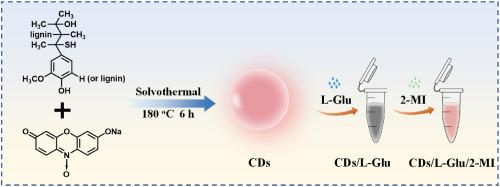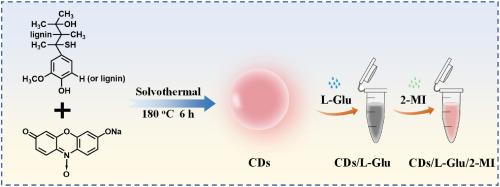Dual-functional carbon dots for fluorescent detection of L-Glutamic acid and 2-Methylimidazole in complex matrices: Applications in food safety and environmental monitoring
IF 6
2区 化学
Q1 CHEMISTRY, ANALYTICAL
引用次数: 0
Abstract
Background
L-Glutamic acid (L-Glu) serves as both an umami substance in foods and a key neurotransmitter, yet abnormal levels may cause metabolic disorders and neurological disorders. 2-Methylimidazole (2-MI), a synthetic compound used in metal-organic frameworks (MOFs), pesticides, and dyes, is formed during caramel color production. It exhibits toxicity and carcinogenicity and poses environmental risks due to industrial discharge. However, conventional detection methods are limited by their reliance on costly instrumentation and specialized personnel. Therefore, there is an urgent need to develop a fluorescent probe for detecting L-Glu and 2-MI that is easy to operate, rapid in response, and highly sensitive.
Results
Using a solvothermal technique, carbon dots (CDs) were fabricated from alkaline lignin and resazurin and were characterized as spherical nanoparticles (11.0 ± 3.4 nm) with graphitic structure and oxygen/nitrogen/sulfur-containing surface groups. These CDs exhibited excitation-independent orange emission (λex/λem = 571/582 nm), ionic stability, and reversible pH sensitivity (pKa = 4.54). Capitalizing on their selective fluorescence response, CDs served as a dual-functional probe: L-Glutamic acid (L-Glu) selectively quenched CDs fluorescence via static quenching (LOD = 0.17 μM, linear range 0–20 μM), while 2-Methylimidazole (2-MI) restored fluorescence in the CDs/L-Glu system (LOD = 0.39/0.14 μM, linear range 0–50/50–100 μM).
Significance
The probe demonstrated exceptional anti-interference capability against coexisting ions/analytes and operational simplicity. Validated in actual world matrices, standard addition recoveries ranged from 87.44 to 111.38 % for L-Glu in kelp soup/purified drinking water and 93.23–107.01 % for 2-MI in snowmelt/purified drinking water. This work establishes CDs as a robust platform for the rapid detection of food safety and environmental contaminants.


复合基质中l-谷氨酸和2-甲基咪唑的双功能碳点荧光检测:在食品安全和环境监测中的应用
l -谷氨酸(L-Glu)既是食物中的鲜味物质,也是一种重要的神经递质,但其水平异常可能导致代谢紊乱和神经系统疾病。2-甲基咪唑(2-MI)是一种用于金属有机框架(MOFs)、杀虫剂和染料的合成化合物,在焦糖色素生产过程中形成。它具有毒性和致癌性,并因工业排放而造成环境风险。然而,传统的检测方法由于依赖昂贵的仪器和专业人员而受到限制。因此,迫切需要开发一种操作简便、反应速度快、灵敏度高的L-Glu和2-MI荧光探针。结果采用溶剂热法制备了碱性木质素和复蓝蛋白为原料的碳点(CDs),其结构为球形纳米颗粒(11.0±3.4 nm),表面含有氧/氮/硫基团。这些CDs具有与激发无关的橙色发射(λex/λem = 571/ 582nm)、离子稳定性和可逆pH敏感性(pKa = 4.54)。利用CDs的选择性荧光响应,CDs作为双功能探针:l-谷氨酸(L-Glu)通过静态猝灭选择性猝灭CDs的荧光(LOD = 0.17 μM,线性范围0-20 μM),而2-甲基咪唑(2-MI)在CDs/L-Glu体系中恢复荧光(LOD = 0.39/0.14 μM,线性范围0-50/50-100 μM)。该探针对共存离子/分析物具有出色的抗干扰能力,操作简单。在实际基质中验证,海带汤/纯化饮用水中L-Glu的标准添加回收率为87.44 ~ 111.38%,雪水/纯化饮用水中2-MI的标准添加回收率为93.23 ~ 107.01%。这项工作建立了cd作为快速检测食品安全和环境污染物的强大平台。
本文章由计算机程序翻译,如有差异,请以英文原文为准。
求助全文
约1分钟内获得全文
求助全文
来源期刊

Analytica Chimica Acta
化学-分析化学
CiteScore
10.40
自引率
6.50%
发文量
1081
审稿时长
38 days
期刊介绍:
Analytica Chimica Acta has an open access mirror journal Analytica Chimica Acta: X, sharing the same aims and scope, editorial team, submission system and rigorous peer review.
Analytica Chimica Acta provides a forum for the rapid publication of original research, and critical, comprehensive reviews dealing with all aspects of fundamental and applied modern analytical chemistry. The journal welcomes the submission of research papers which report studies concerning the development of new and significant analytical methodologies. In determining the suitability of submitted articles for publication, particular scrutiny will be placed on the degree of novelty and impact of the research and the extent to which it adds to the existing body of knowledge in analytical chemistry.
 求助内容:
求助内容: 应助结果提醒方式:
应助结果提醒方式:


